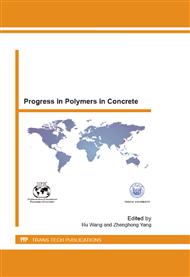p.136
p.144
p.150
p.155
p.161
p.166
p.175
p.185
p.191
Damping Properties of EVA Modified Cement Pastes
Abstract:
Earthquakes, wind buffeting, ocean waves, noise vibration and explosion are all harmful to people’s life. For controlling the vibrations, one way is by improving the material damping capacity. Effects of improving the damping properties of cement based material by adding polymer, fiber and interfacial modification have been admitted. Whereas the relationship of the influence of the dosage of polymer to the damping functions and the changes of damping behaviors at different frequency, temperature environment have received much less attention. Furthermore, ethylene-vinyl acetate (EVA) which used as one of the mainly modified has been widely applied in various aspects such as improving ductility, impermeability and mechanical properties. However, the ability of EVA modification in cement on improving the damping capacity has received less attention. The main objective of this paper is to research the damping behavior of EVA modified cement pastes at different frequencies, temperatures and polymer contents by dynamic mechanical analyzer. Experimental results showed that damping property of EVA modification in cement was dramatically increased. For a certain EVA modified cement paste, tanδ slightly increases with the frequency increases and a sharp peak was found at the glass transition temperature. The SEM images indicated that there was a morphological difference in the plain cement paste and EVA modified cement paste.
Info:
Periodical:
Pages:
161-165
Citation:
Online since:
April 2013
Authors:
Keywords:
Price:
Сopyright:
© 2013 Trans Tech Publications Ltd. All Rights Reserved
Share:
Citation:


